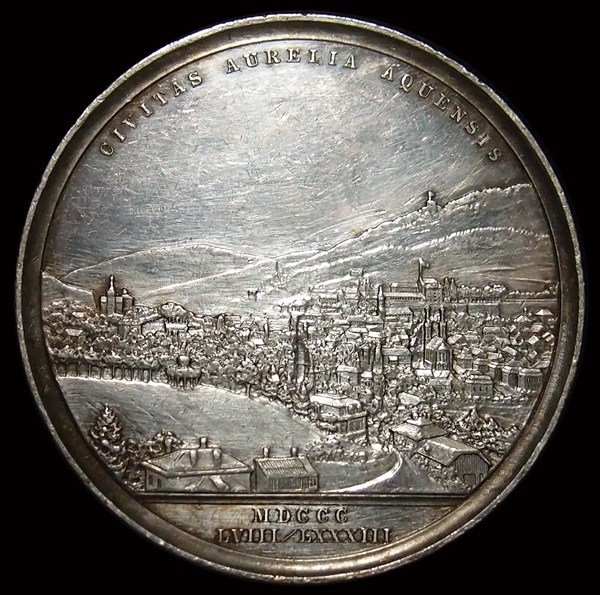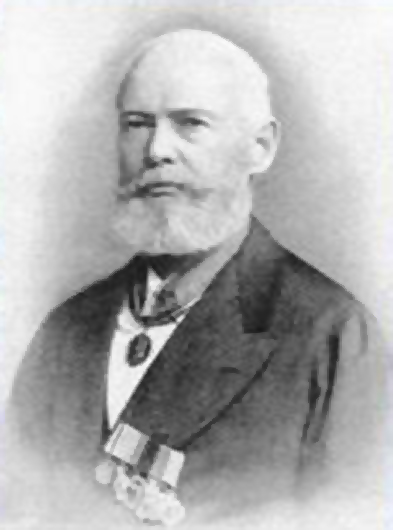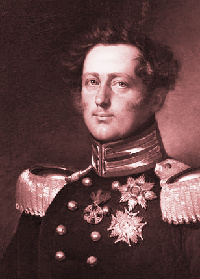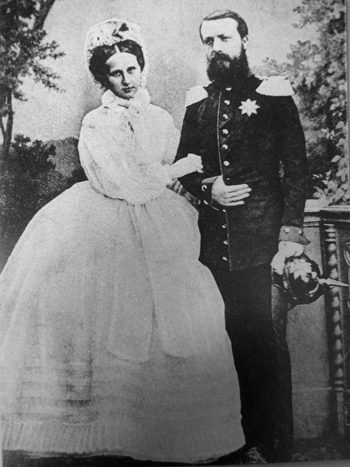
SILVER CITY COMMEMORATIVE MEDAL FOR BADEN-BADEN
Year: 1883
Obverse: Portraits of Grand Duke Friedrich Wilhelm Ludwig von Baden (Friedrich I, Gro▀herzog von Baden) and his wife Princess Louise of Prussia / W. Kullrich A.V. Fecit
Reverse: The Spa Town of Baden-Baden - CIVITAS AURELIA AQUENSIS / MDCCC-LVIII / LXXXIII (1858/83)
Engraver: Friedrich Wilhelm Kullrich
This silver medal features on the Obverse an outstanding double portrait of Friedrich I Grand Duke of Baden and his wife Princess Louise of Prussia, daughter of Kaiser Wilhelm I. Below and on the rim is W. KULLRICH A. V. FECIT (Made by Friedrich Wilhelm Kullrich in the Eleventh Month of the Year 1883) . On the Reverse is pictured the town of Baden-Baden identified by its ancient Roman name 'Civitas Aurelia Aquensis.' with 'MDCCC - LVIII / LXXXIII: (1858 / 83)' under the detailed city relief.
This medal was produced by the the prolific and highly talented artist, engraver and medalist Friedrich Wilhelm Kullrich. Born on December 18, 1821 to Johan Friedrich Kullrich and his wife Johanna Christina at Dahme in Brandenburg, a province of the Kingdom of Prussia, Kullrich began working with metals early as an apprentice to his father who was a blacksmith / gunsmith. Friedrich Wilhelm served a brief stint in the military, briefly studied veterinary medicine and traveled quite extensively apprenticing in various workshops until he entered the employ of the medalist and ivory sculptor Professor Karl Fisch in 1844 where he began to learn engraving. He then found employment in the workshop of the sculptor Christian Rauch who recommended Kullrich to the Berlin Art Academy where he studied sculpture and engraving. Rauch also entrusted him with the task of engraving the commemorative medal of the Equestrian Statue of Frederick the Great in Berlin. Kullrich graduated from of the Berlin Academy of Art by 1851 and worked for a time die-sinking for Gottfried Bernhard Loos at The Loos Medallic Establishment before accepting an offer to work in the Royal Mint in London to work under William Wyon, a position where he undoubtedly learned a great deal from that highly accomplished master. By 1855 he had become a master journeyman who worked for several years in various workshops in Brussels, Paris, Munich and Switzerland until 1857 when he was invited by the Russian Tsar Alexander II to improve the organization of the mint in St. Petersburg. He was offered a permanent position there by the Russian government but did not accept.
Instead he accepted a staff position at the Royal Mint of Berlin in 1858 and was quickly promoted to medalist the next year. By 1862 he was appointed Chief-Medalist and was also put to the task of engraving dies for official Prussian coins as well as the dies for other German princely states such as Anhalt, Schleiz, Obergreis, Mecklemburg, Schwerin, Stielitz and Reus among others. With the creation of the German Empire, Kullrich was commissioned to produce all of the obverse dies for the imperial coinage. He was also commissioned to produce dies and commemorative medals for Norway, Egypt, Romania, Brazil and Costa Rica as well as many commemorative medals for private citizens, cities, townships and various organizations. Many of his dies would continue to be used long after his death in 1887. Kullrich also served as a consultant to the Romanian government on the establishment of the National Mint n Bucharest, which was opened in 1870. He was then commissioned to create the dies for their coinage which he created in his workshop in Berlin. Friedrich Wilhelm Kullrich died in Berlin on September 1, 1887. He left behind a son, the architect Friedrich Kullrich, and another son Reinhard Kullrich, who was also an engraver and also worked at the Berlin Mint. He also left behind a lasting legacy through his dedication to the highest level of artistry and craftsmanship in coins and medals as well as a prolific body of work that defines the coinage of the late German States and Imperial era German coins and medals.
In his father Leopold the people saw a new hope as he was educated in political science at the University of Heidelberg, traveled extensively, was a patron of the arts and promoted agricultural, social and political reform. The populist reformers of Baden had good reason to be hopeful with the ascension of Leopold in 1830. He appointed a new cabinet with progressive-thinking members, called for free and unrestricted elections to the new legislative chambers and on Christmas of 1831 he issued a liberal press law which outlawed censorship, something unprecedented in the German States at that time. While the members of the new legislature were not all liberal reformers, they were certainly favorable to taking concessionary measures to maintain order. His early reign saw the introduction of liberal reforms to the constitution, criminal and civil law, and education. Industrial development and transport also progressed rapidly under his government with the development of a robust railway network and increased commercial navigation on the Rhine. Leopold supported growth in industry and trade by joining the German Customs Union in 1835. The growth of industry created many new jobs as well as an ever growing income differential between the wealthy bourgeoisie and the working class. Unfortunately he was not without detractors in and outside of Baden. His reform measures did not go unnoticed by other rulers in the German Confederation and he was pressured by many of them into pulling back many of those reforms including the free-press. But the damage had already been done and revolutionary sentiments grew quickly in both the private citizens and the military leading to armed uprisings which forced Leopold to leave Baden in fear for his life. He did not return until the revolutionary forces had been crush through the intervention of Wilhelm of Prussia who occupied Baden, reversed most of the liberal reforms and reinstated Leopold's rule. With the death of Leopold the Duchy passed for a brief time to his son Ludwig II who by that time was suffering from some form of mental illness. Already serving as regent since 1852 in the place of his brother, who was deemed 'mentally unfit' to serve, Friedrich formally became Grand Duke Friedrich I von Baden on January 22, 1858 upon his brother passing. The long tenure of Friedrich could be considered the calm before the storm. Under Friedrich I, liberal reforms were again instituted with direct elections to the Parliament of Baden being held furthering the inevitable progression towards more democratic forms of government. His support for a constitutional monarchy would open the door to further reforms, the type of which was being demanded more and more urgently all over Europe, gradually pulling it away from feudal and autocratic government. These reforms, World War I and the German Revolution of 1918-19 resulted in the abolition of the Grand Duchy, and the title of Grand Duke of Baden, under his son and successor Friedrich II.
1883 was a big year for the town of Baden-Baden. The Iffezheim Racecourse (shown in foreground) was holding its 25th Grosser Preis von Baden. The 25th year of Germany's most prestigious thoroughbred horse race held every year since the first races in 1858. This medal is to celebrate the races, the rule, and the hot baths of Baden Baden that every year brought thousands of visitors from across the German States, Europe and the World. The Reverse of this medal shows the city of Baden-Baden nestled in the eastern foothills of the Black Forest, on the banks of the river Oos. The medal identifies the town using the name it was given by the Romans who settled this remote and hostile area as far back as the reign of the Emperor Hadrian: Civitas Aurelia Aquensis ("Aurelia-of-the-Waters"). The natural hot springs of Civitas Aurelia Aquensis were known to the Romans who named it after the emperor Marcus Aurelius Severus Alexander however it was a known spot for what was believed to be curative hot springs for some time before. The place was known to the Roman garrison stationed in what is now modern Strasbourg and The emperor Caracalla is believed to have visited the area to ease the pain and swelling from his arthritis. Fragments of ancient Roman sculptures as well as remains of Roman vapour baths have been found there. The town was renamed Baden when it became the residence of the Margraves of Baden but is known now as Baden-Baden meaning "Baden in Baden" or "Baden in the state of Baden." There are 29 natural hot springs in the area, with water rich in salt and other minerals flowing from artesian wells. This water is then piped into various baths located in town. Baden-Baden was known as "Europe's summer capital" because it's normally modest population would swell with visitors at this time as people sought relaxation, recreation and the possible curative properties of the waters. Baden-Baden continues to be a a popular destination for the hot springs, for its natural beauty, recreation and the mild climate.
|










